Effect of COVID-19 on Aviation Business: Case Study on Ryanair
VerifiedAdded on 2023/01/10
|7
|1921
|81
AI Summary
This literature review examines the impact of COVID-19 on the business performance of the aviation industry, with a focus on Ryanair. It explores the understanding of the pandemic and analyzes its effect on the airline industry in the UK. The review also discusses the challenges faced by the industry and the potential long-term changes in passenger behavior and safety measures.
Contribute Materials
Your contribution can guide someone’s learning journey. Share your
documents today.
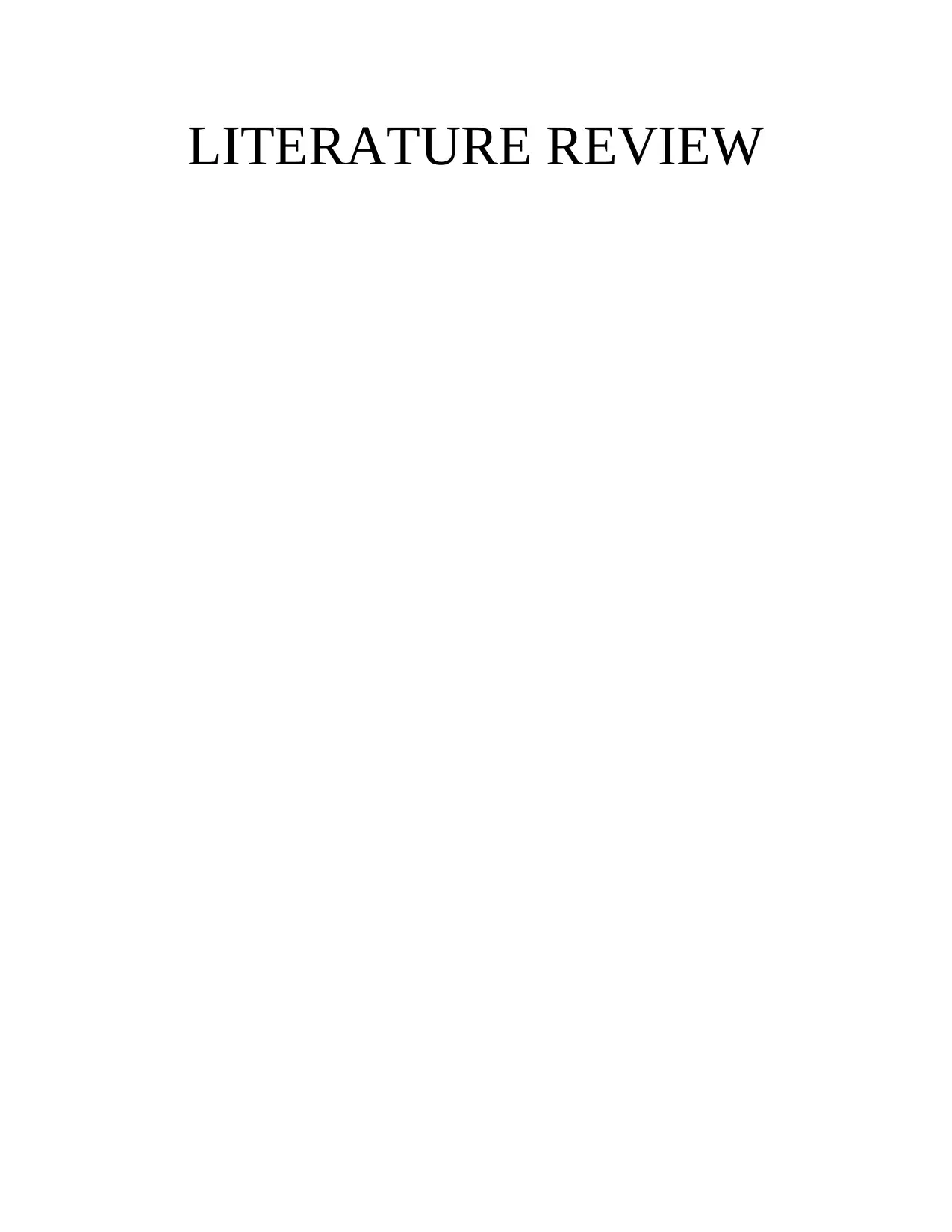
LITERATURE REVIEW
Secure Best Marks with AI Grader
Need help grading? Try our AI Grader for instant feedback on your assignments.
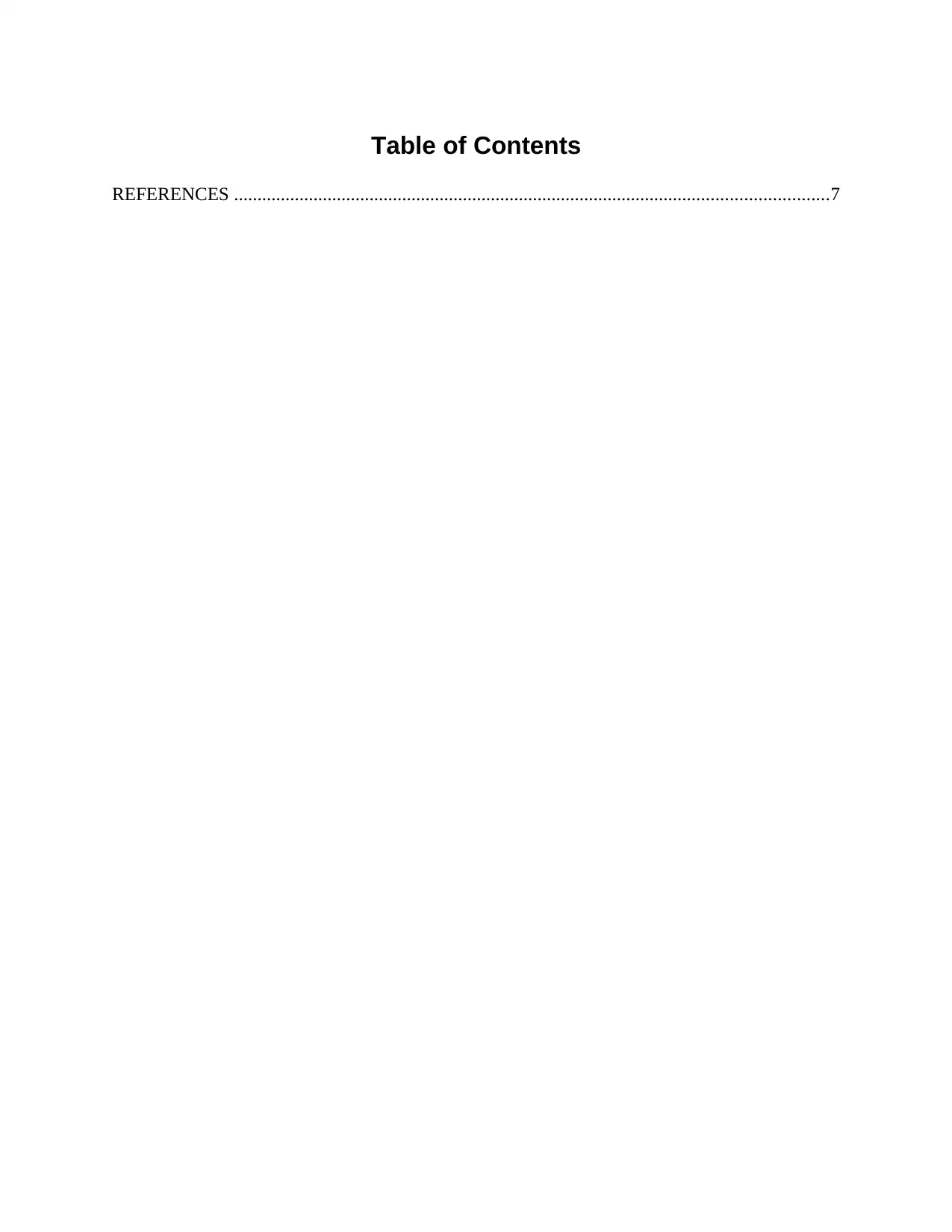
Table of Contents
REFERENCES ...............................................................................................................................7
REFERENCES ...............................................................................................................................7
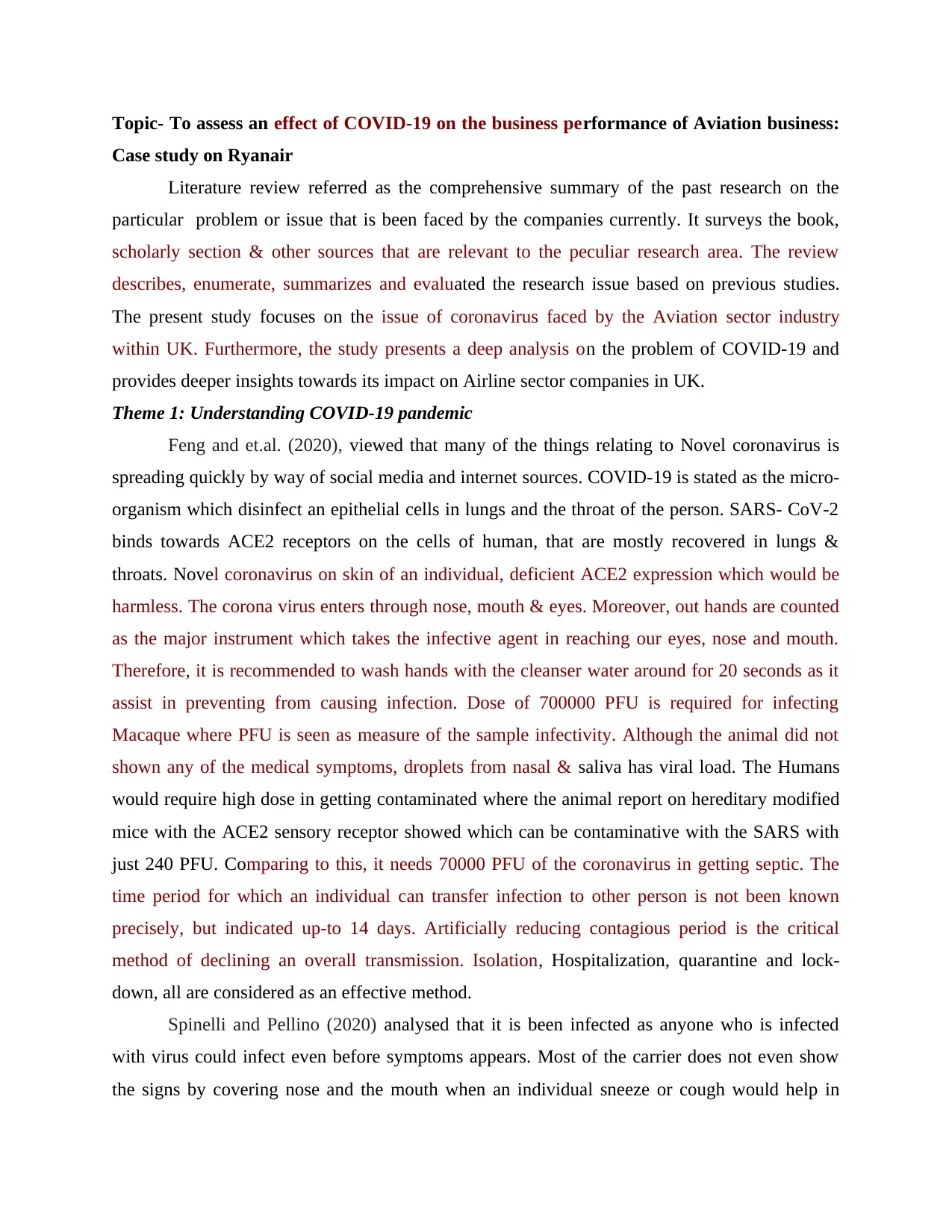
Topic- To assess an effect of COVID-19 on the business performance of Aviation business:
Case study on Ryanair
Literature review referred as the comprehensive summary of the past research on the
particular problem or issue that is been faced by the companies currently. It surveys the book,
scholarly section & other sources that are relevant to the peculiar research area. The review
describes, enumerate, summarizes and evaluated the research issue based on previous studies.
The present study focuses on the issue of coronavirus faced by the Aviation sector industry
within UK. Furthermore, the study presents a deep analysis on the problem of COVID-19 and
provides deeper insights towards its impact on Airline sector companies in UK.
Theme 1: Understanding COVID-19 pandemic
Feng and et.al. (2020), viewed that many of the things relating to Novel coronavirus is
spreading quickly by way of social media and internet sources. COVID-19 is stated as the micro-
organism which disinfect an epithelial cells in lungs and the throat of the person. SARS- CoV-2
binds towards ACE2 receptors on the cells of human, that are mostly recovered in lungs &
throats. Novel coronavirus on skin of an individual, deficient ACE2 expression which would be
harmless. The corona virus enters through nose, mouth & eyes. Moreover, out hands are counted
as the major instrument which takes the infective agent in reaching our eyes, nose and mouth.
Therefore, it is recommended to wash hands with the cleanser water around for 20 seconds as it
assist in preventing from causing infection. Dose of 700000 PFU is required for infecting
Macaque where PFU is seen as measure of the sample infectivity. Although the animal did not
shown any of the medical symptoms, droplets from nasal & saliva has viral load. The Humans
would require high dose in getting contaminated where the animal report on hereditary modified
mice with the ACE2 sensory receptor showed which can be contaminative with the SARS with
just 240 PFU. Comparing to this, it needs 70000 PFU of the coronavirus in getting septic. The
time period for which an individual can transfer infection to other person is not been known
precisely, but indicated up-to 14 days. Artificially reducing contagious period is the critical
method of declining an overall transmission. Isolation, Hospitalization, quarantine and lock-
down, all are considered as an effective method.
Spinelli and Pellino (2020) analysed that it is been infected as anyone who is infected
with virus could infect even before symptoms appears. Most of the carrier does not even show
the signs by covering nose and the mouth when an individual sneeze or cough would help in
Case study on Ryanair
Literature review referred as the comprehensive summary of the past research on the
particular problem or issue that is been faced by the companies currently. It surveys the book,
scholarly section & other sources that are relevant to the peculiar research area. The review
describes, enumerate, summarizes and evaluated the research issue based on previous studies.
The present study focuses on the issue of coronavirus faced by the Aviation sector industry
within UK. Furthermore, the study presents a deep analysis on the problem of COVID-19 and
provides deeper insights towards its impact on Airline sector companies in UK.
Theme 1: Understanding COVID-19 pandemic
Feng and et.al. (2020), viewed that many of the things relating to Novel coronavirus is
spreading quickly by way of social media and internet sources. COVID-19 is stated as the micro-
organism which disinfect an epithelial cells in lungs and the throat of the person. SARS- CoV-2
binds towards ACE2 receptors on the cells of human, that are mostly recovered in lungs &
throats. Novel coronavirus on skin of an individual, deficient ACE2 expression which would be
harmless. The corona virus enters through nose, mouth & eyes. Moreover, out hands are counted
as the major instrument which takes the infective agent in reaching our eyes, nose and mouth.
Therefore, it is recommended to wash hands with the cleanser water around for 20 seconds as it
assist in preventing from causing infection. Dose of 700000 PFU is required for infecting
Macaque where PFU is seen as measure of the sample infectivity. Although the animal did not
shown any of the medical symptoms, droplets from nasal & saliva has viral load. The Humans
would require high dose in getting contaminated where the animal report on hereditary modified
mice with the ACE2 sensory receptor showed which can be contaminative with the SARS with
just 240 PFU. Comparing to this, it needs 70000 PFU of the coronavirus in getting septic. The
time period for which an individual can transfer infection to other person is not been known
precisely, but indicated up-to 14 days. Artificially reducing contagious period is the critical
method of declining an overall transmission. Isolation, Hospitalization, quarantine and lock-
down, all are considered as an effective method.
Spinelli and Pellino (2020) analysed that it is been infected as anyone who is infected
with virus could infect even before symptoms appears. Most of the carrier does not even show
the signs by covering nose and the mouth when an individual sneeze or cough would help in
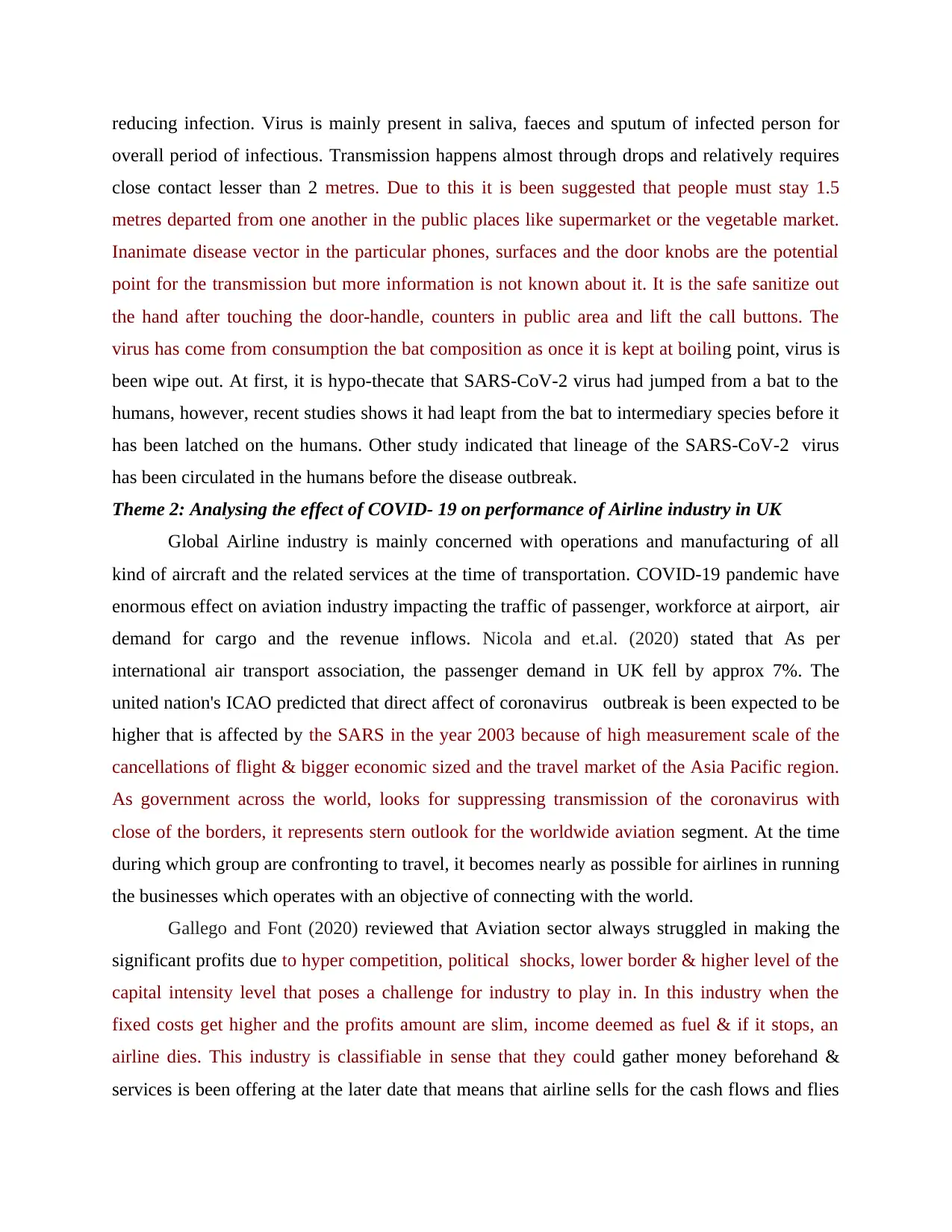
reducing infection. Virus is mainly present in saliva, faeces and sputum of infected person for
overall period of infectious. Transmission happens almost through drops and relatively requires
close contact lesser than 2 metres. Due to this it is been suggested that people must stay 1.5
metres departed from one another in the public places like supermarket or the vegetable market.
Inanimate disease vector in the particular phones, surfaces and the door knobs are the potential
point for the transmission but more information is not known about it. It is the safe sanitize out
the hand after touching the door-handle, counters in public area and lift the call buttons. The
virus has come from consumption the bat composition as once it is kept at boiling point, virus is
been wipe out. At first, it is hypo-thecate that SARS-CoV-2 virus had jumped from a bat to the
humans, however, recent studies shows it had leapt from the bat to intermediary species before it
has been latched on the humans. Other study indicated that lineage of the SARS-CoV-2 virus
has been circulated in the humans before the disease outbreak.
Theme 2: Analysing the effect of COVID- 19 on performance of Airline industry in UK
Global Airline industry is mainly concerned with operations and manufacturing of all
kind of aircraft and the related services at the time of transportation. COVID-19 pandemic have
enormous effect on aviation industry impacting the traffic of passenger, workforce at airport, air
demand for cargo and the revenue inflows. Nicola and et.al. (2020) stated that As per
international air transport association, the passenger demand in UK fell by approx 7%. The
united nation's ICAO predicted that direct affect of coronavirus outbreak is been expected to be
higher that is affected by the SARS in the year 2003 because of high measurement scale of the
cancellations of flight & bigger economic sized and the travel market of the Asia Pacific region.
As government across the world, looks for suppressing transmission of the coronavirus with
close of the borders, it represents stern outlook for the worldwide aviation segment. At the time
during which group are confronting to travel, it becomes nearly as possible for airlines in running
the businesses which operates with an objective of connecting with the world.
Gallego and Font (2020) reviewed that Aviation sector always struggled in making the
significant profits due to hyper competition, political shocks, lower border & higher level of the
capital intensity level that poses a challenge for industry to play in. In this industry when the
fixed costs get higher and the profits amount are slim, income deemed as fuel & if it stops, an
airline dies. This industry is classifiable in sense that they could gather money beforehand &
services is been offering at the later date that means that airline sells for the cash flows and flies
overall period of infectious. Transmission happens almost through drops and relatively requires
close contact lesser than 2 metres. Due to this it is been suggested that people must stay 1.5
metres departed from one another in the public places like supermarket or the vegetable market.
Inanimate disease vector in the particular phones, surfaces and the door knobs are the potential
point for the transmission but more information is not known about it. It is the safe sanitize out
the hand after touching the door-handle, counters in public area and lift the call buttons. The
virus has come from consumption the bat composition as once it is kept at boiling point, virus is
been wipe out. At first, it is hypo-thecate that SARS-CoV-2 virus had jumped from a bat to the
humans, however, recent studies shows it had leapt from the bat to intermediary species before it
has been latched on the humans. Other study indicated that lineage of the SARS-CoV-2 virus
has been circulated in the humans before the disease outbreak.
Theme 2: Analysing the effect of COVID- 19 on performance of Airline industry in UK
Global Airline industry is mainly concerned with operations and manufacturing of all
kind of aircraft and the related services at the time of transportation. COVID-19 pandemic have
enormous effect on aviation industry impacting the traffic of passenger, workforce at airport, air
demand for cargo and the revenue inflows. Nicola and et.al. (2020) stated that As per
international air transport association, the passenger demand in UK fell by approx 7%. The
united nation's ICAO predicted that direct affect of coronavirus outbreak is been expected to be
higher that is affected by the SARS in the year 2003 because of high measurement scale of the
cancellations of flight & bigger economic sized and the travel market of the Asia Pacific region.
As government across the world, looks for suppressing transmission of the coronavirus with
close of the borders, it represents stern outlook for the worldwide aviation segment. At the time
during which group are confronting to travel, it becomes nearly as possible for airlines in running
the businesses which operates with an objective of connecting with the world.
Gallego and Font (2020) reviewed that Aviation sector always struggled in making the
significant profits due to hyper competition, political shocks, lower border & higher level of the
capital intensity level that poses a challenge for industry to play in. In this industry when the
fixed costs get higher and the profits amount are slim, income deemed as fuel & if it stops, an
airline dies. This industry is classifiable in sense that they could gather money beforehand &
services is been offering at the later date that means that airline sells for the cash flows and flies
Secure Best Marks with AI Grader
Need help grading? Try our AI Grader for instant feedback on your assignments.
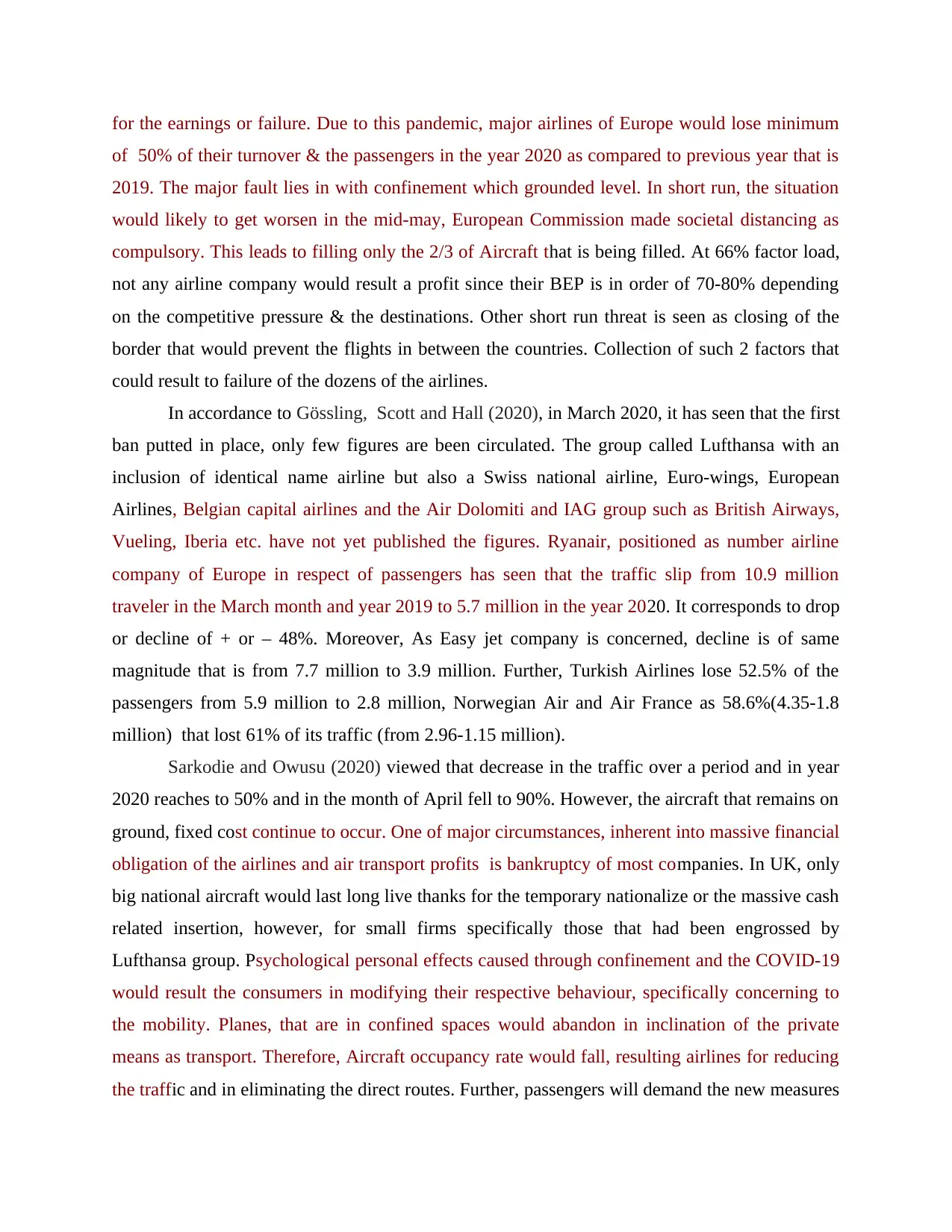
for the earnings or failure. Due to this pandemic, major airlines of Europe would lose minimum
of 50% of their turnover & the passengers in the year 2020 as compared to previous year that is
2019. The major fault lies in with confinement which grounded level. In short run, the situation
would likely to get worsen in the mid-may, European Commission made societal distancing as
compulsory. This leads to filling only the 2/3 of Aircraft that is being filled. At 66% factor load,
not any airline company would result a profit since their BEP is in order of 70-80% depending
on the competitive pressure & the destinations. Other short run threat is seen as closing of the
border that would prevent the flights in between the countries. Collection of such 2 factors that
could result to failure of the dozens of the airlines.
In accordance to Gössling, Scott and Hall (2020), in March 2020, it has seen that the first
ban putted in place, only few figures are been circulated. The group called Lufthansa with an
inclusion of identical name airline but also a Swiss national airline, Euro-wings, European
Airlines, Belgian capital airlines and the Air Dolomiti and IAG group such as British Airways,
Vueling, Iberia etc. have not yet published the figures. Ryanair, positioned as number airline
company of Europe in respect of passengers has seen that the traffic slip from 10.9 million
traveler in the March month and year 2019 to 5.7 million in the year 2020. It corresponds to drop
or decline of + or – 48%. Moreover, As Easy jet company is concerned, decline is of same
magnitude that is from 7.7 million to 3.9 million. Further, Turkish Airlines lose 52.5% of the
passengers from 5.9 million to 2.8 million, Norwegian Air and Air France as 58.6%(4.35-1.8
million) that lost 61% of its traffic (from 2.96-1.15 million).
Sarkodie and Owusu (2020) viewed that decrease in the traffic over a period and in year
2020 reaches to 50% and in the month of April fell to 90%. However, the aircraft that remains on
ground, fixed cost continue to occur. One of major circumstances, inherent into massive financial
obligation of the airlines and air transport profits is bankruptcy of most companies. In UK, only
big national aircraft would last long live thanks for the temporary nationalize or the massive cash
related insertion, however, for small firms specifically those that had been engrossed by
Lufthansa group. Psychological personal effects caused through confinement and the COVID-19
would result the consumers in modifying their respective behaviour, specifically concerning to
the mobility. Planes, that are in confined spaces would abandon in inclination of the private
means as transport. Therefore, Aircraft occupancy rate would fall, resulting airlines for reducing
the traffic and in eliminating the direct routes. Further, passengers will demand the new measures
of 50% of their turnover & the passengers in the year 2020 as compared to previous year that is
2019. The major fault lies in with confinement which grounded level. In short run, the situation
would likely to get worsen in the mid-may, European Commission made societal distancing as
compulsory. This leads to filling only the 2/3 of Aircraft that is being filled. At 66% factor load,
not any airline company would result a profit since their BEP is in order of 70-80% depending
on the competitive pressure & the destinations. Other short run threat is seen as closing of the
border that would prevent the flights in between the countries. Collection of such 2 factors that
could result to failure of the dozens of the airlines.
In accordance to Gössling, Scott and Hall (2020), in March 2020, it has seen that the first
ban putted in place, only few figures are been circulated. The group called Lufthansa with an
inclusion of identical name airline but also a Swiss national airline, Euro-wings, European
Airlines, Belgian capital airlines and the Air Dolomiti and IAG group such as British Airways,
Vueling, Iberia etc. have not yet published the figures. Ryanair, positioned as number airline
company of Europe in respect of passengers has seen that the traffic slip from 10.9 million
traveler in the March month and year 2019 to 5.7 million in the year 2020. It corresponds to drop
or decline of + or – 48%. Moreover, As Easy jet company is concerned, decline is of same
magnitude that is from 7.7 million to 3.9 million. Further, Turkish Airlines lose 52.5% of the
passengers from 5.9 million to 2.8 million, Norwegian Air and Air France as 58.6%(4.35-1.8
million) that lost 61% of its traffic (from 2.96-1.15 million).
Sarkodie and Owusu (2020) viewed that decrease in the traffic over a period and in year
2020 reaches to 50% and in the month of April fell to 90%. However, the aircraft that remains on
ground, fixed cost continue to occur. One of major circumstances, inherent into massive financial
obligation of the airlines and air transport profits is bankruptcy of most companies. In UK, only
big national aircraft would last long live thanks for the temporary nationalize or the massive cash
related insertion, however, for small firms specifically those that had been engrossed by
Lufthansa group. Psychological personal effects caused through confinement and the COVID-19
would result the consumers in modifying their respective behaviour, specifically concerning to
the mobility. Planes, that are in confined spaces would abandon in inclination of the private
means as transport. Therefore, Aircraft occupancy rate would fall, resulting airlines for reducing
the traffic and in eliminating the direct routes. Further, passengers will demand the new measures
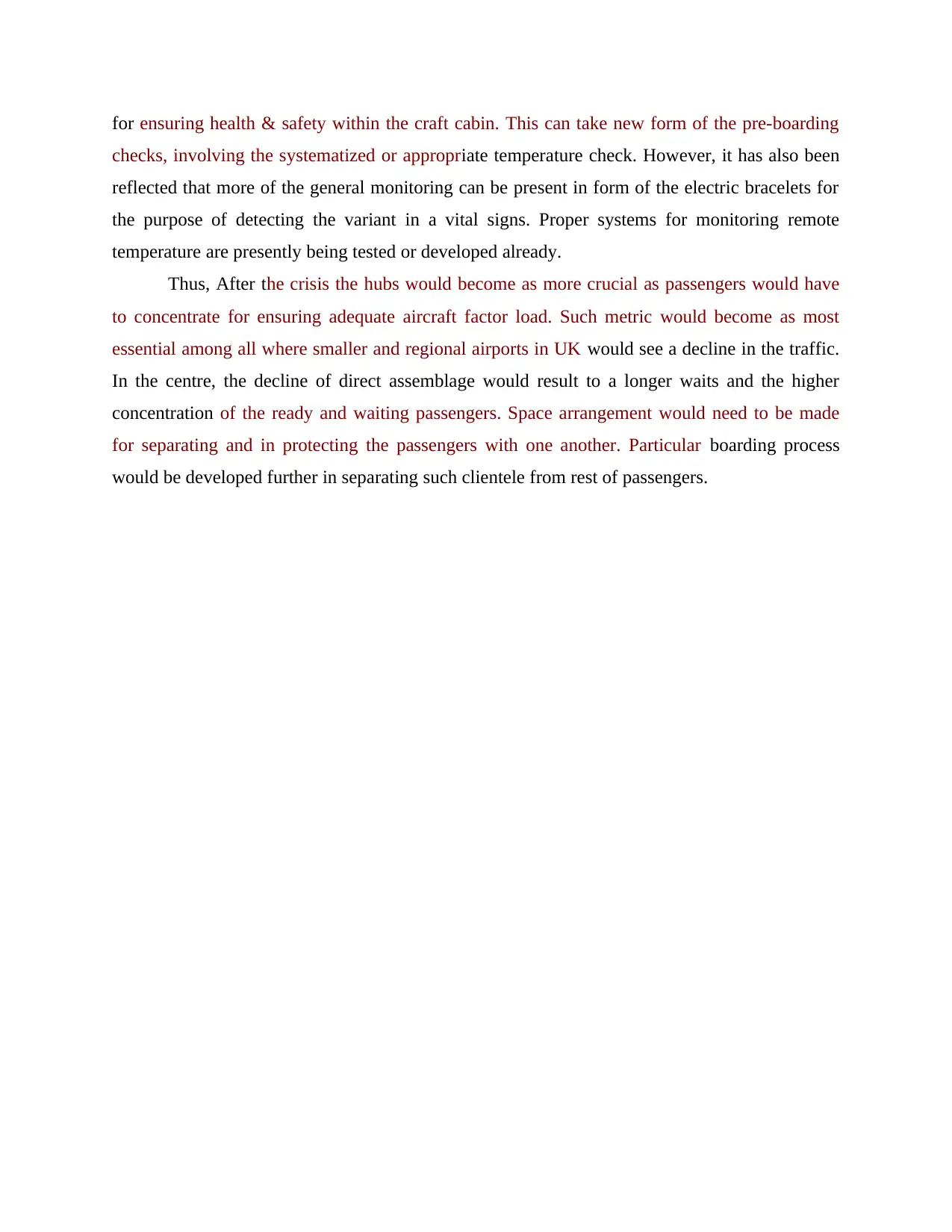
for ensuring health & safety within the craft cabin. This can take new form of the pre-boarding
checks, involving the systematized or appropriate temperature check. However, it has also been
reflected that more of the general monitoring can be present in form of the electric bracelets for
the purpose of detecting the variant in a vital signs. Proper systems for monitoring remote
temperature are presently being tested or developed already.
Thus, After the crisis the hubs would become as more crucial as passengers would have
to concentrate for ensuring adequate aircraft factor load. Such metric would become as most
essential among all where smaller and regional airports in UK would see a decline in the traffic.
In the centre, the decline of direct assemblage would result to a longer waits and the higher
concentration of the ready and waiting passengers. Space arrangement would need to be made
for separating and in protecting the passengers with one another. Particular boarding process
would be developed further in separating such clientele from rest of passengers.
checks, involving the systematized or appropriate temperature check. However, it has also been
reflected that more of the general monitoring can be present in form of the electric bracelets for
the purpose of detecting the variant in a vital signs. Proper systems for monitoring remote
temperature are presently being tested or developed already.
Thus, After the crisis the hubs would become as more crucial as passengers would have
to concentrate for ensuring adequate aircraft factor load. Such metric would become as most
essential among all where smaller and regional airports in UK would see a decline in the traffic.
In the centre, the decline of direct assemblage would result to a longer waits and the higher
concentration of the ready and waiting passengers. Space arrangement would need to be made
for separating and in protecting the passengers with one another. Particular boarding process
would be developed further in separating such clientele from rest of passengers.
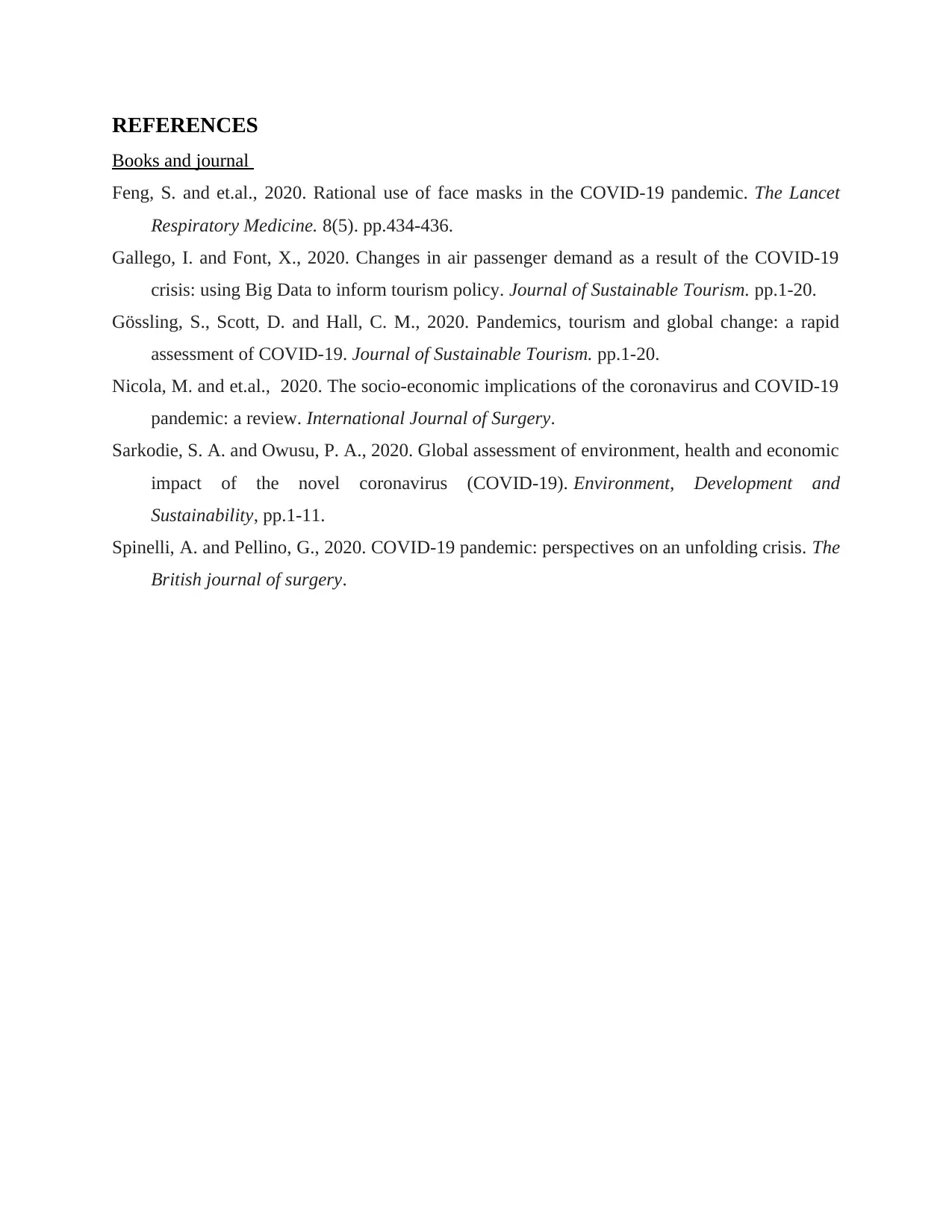
REFERENCES
Books and journal
Feng, S. and et.al., 2020. Rational use of face masks in the COVID-19 pandemic. The Lancet
Respiratory Medicine. 8(5). pp.434-436.
Gallego, I. and Font, X., 2020. Changes in air passenger demand as a result of the COVID-19
crisis: using Big Data to inform tourism policy. Journal of Sustainable Tourism. pp.1-20.
Gössling, S., Scott, D. and Hall, C. M., 2020. Pandemics, tourism and global change: a rapid
assessment of COVID-19. Journal of Sustainable Tourism. pp.1-20.
Nicola, M. and et.al., 2020. The socio-economic implications of the coronavirus and COVID-19
pandemic: a review. International Journal of Surgery.
Sarkodie, S. A. and Owusu, P. A., 2020. Global assessment of environment, health and economic
impact of the novel coronavirus (COVID-19). Environment, Development and
Sustainability, pp.1-11.
Spinelli, A. and Pellino, G., 2020. COVID‐19 pandemic: perspectives on an unfolding crisis. The
British journal of surgery.
Books and journal
Feng, S. and et.al., 2020. Rational use of face masks in the COVID-19 pandemic. The Lancet
Respiratory Medicine. 8(5). pp.434-436.
Gallego, I. and Font, X., 2020. Changes in air passenger demand as a result of the COVID-19
crisis: using Big Data to inform tourism policy. Journal of Sustainable Tourism. pp.1-20.
Gössling, S., Scott, D. and Hall, C. M., 2020. Pandemics, tourism and global change: a rapid
assessment of COVID-19. Journal of Sustainable Tourism. pp.1-20.
Nicola, M. and et.al., 2020. The socio-economic implications of the coronavirus and COVID-19
pandemic: a review. International Journal of Surgery.
Sarkodie, S. A. and Owusu, P. A., 2020. Global assessment of environment, health and economic
impact of the novel coronavirus (COVID-19). Environment, Development and
Sustainability, pp.1-11.
Spinelli, A. and Pellino, G., 2020. COVID‐19 pandemic: perspectives on an unfolding crisis. The
British journal of surgery.
1 out of 7
Related Documents
Your All-in-One AI-Powered Toolkit for Academic Success.
+13062052269
info@desklib.com
Available 24*7 on WhatsApp / Email
![[object Object]](/_next/static/media/star-bottom.7253800d.svg)
Unlock your academic potential
© 2024 | Zucol Services PVT LTD | All rights reserved.





